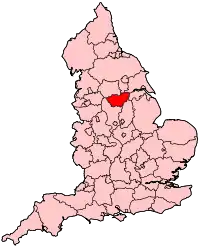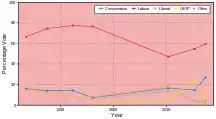| Barnsley East | |
|---|---|
| County constituency for the House of Commons | |
 Boundary of Barnsley East in South Yorkshire in 2010. | |
 Location of South Yorkshire within England. | |
| County | South Yorkshire |
| Electorate | 68,448 (December 2019)[1] |
| Major settlements | Wombwell |
| Current constituency | |
| Created | 2010 |
| Member of Parliament | Stephanie Peacock (Labour) |
| Seats | 1 |
| Created from | Barnsley East & Mexborough, Barnsley West & Penistone and Barnsley Central[2] |
| 1983–1997 | |
| Created from | Barnsley and Dearne Valley |
| Replaced by | Barnsley East and Mexborough |
Barnsley East is a constituency[n 1] in South Yorkshire,[n 2] represented since 2017 by Stephanie Peacock of the Labour Party.
Further to the completion of the 2023 Periodic Review of Westminster constituencies, the seat will be subject to boundary changes. As a consequence, it will be renamed Barnsley South, to be first contested at the next general election.[3]
Constituency profile
The seat covers the south-east suburbs of Barnsley and former coal mining areas such as Hoyland, Darfield and Wombwell. Its residents are poorer than the UK average.[4]
History
The seat was created as Barnsley East in 1983 and later abolished in 1997 to create Barnsley East and Mexborough. It was recreated as Barnsley East at the 2010 general election.
Eight candidates competed for the seat in the 2010 general election; however, the largest two opposition parties failed to gain more than 18.2% each and the winning candidate Michael Dugher managed to obtain 47% of all votes despite the presence of a candidate from the Socialist Labour Party. Although the percentage decline in the Labour vote was the largest in the country (at nearly 24%), they still won the seat safely. In 2017, Stephanie Peacock succeeded Dugher as MP for Barnsley East.
Both between 1983 and 1997, and at the 2010 general election, this constituency has been a safe seat for the Labour Party, as indeed was its temporary replacement, Barnsley East and Mexborough. After the 2019 general election however, this constituency became a marginal seat, with Labour's vote share dropping by 21.9% and their majority cut to just 8.4%.
Boundaries
1983–1997: The Metropolitan Borough of Barnsley wards of Brierley, Cudworth, Darfield, Dearne South, Dearne Thurnscoe, Wombwell North, and Wombwell South.
2010–present: The Metropolitan Borough of Barnsley wards of Cudworth, Darfield, Hoyland Milton, North East, Rockingham, Stairfoot, Wombwell, and Worsbrough.
Following their review of parliamentary representation in South Yorkshire for the 2010 general election, the Boundary Commission for England divided the existing Barnsley East and Mexborough seat to split off Barnsley East from Mexborough, to create the new Barnsley East constituency.
Members of Parliament
MPs 1983–1997
| Election | Member[5] | Party | ||
|---|---|---|---|---|
| 1983 | Terry Patchett | Labour | ||
| 1996 by-election | Jeff Ennis | Labour | ||
| 1997 | Constituency abolished: see Barnsley East and Mexborough & Barnsley Central | |||
MPs since 2010
| Election | Member[5] | Party | |
|---|---|---|---|
| 2010 | Michael Dugher | Labour | |
| 2017 | Stephanie Peacock | Labour | |
Elections

Elections in the 2010s
| Party | Candidate | Votes | % | ±% | |
|---|---|---|---|---|---|
| Labour | Stephanie Peacock | 14,329 | 37.6 | ||
| Brexit Party | Jim Ferguson | 11,112 | 29.2 | New | |
| Conservative | Adam Gregg | 10,377 | 27.3 | ||
| Liberal Democrats | Sophie Thornton | 1,330 | 3.5 | ||
| Green | Richard Trotman | 922 | 2.4 | New | |
| Majority | 3,217 | 8.4 | |||
| Turnout | 38,070 | 54.8 | |||
| Labour hold | Swing | ||||
| Party | Candidate | Votes | % | ±% | |
|---|---|---|---|---|---|
| Labour | Stephanie Peacock | 24,280 | 59.5 | +4.8 | |
| Conservative | Andrew Lloyd | 10,997 | 27.0 | +12.4 | |
| UKIP | James Dalton | 3,247 | 8.0 | −15.5 | |
| Yorkshire | Tony Devoy | 1,215 | 3.0 | +1.3 | |
| Liberal Democrats | Nicola Turner | 750 | 1.8 | −1.4 | |
| English Democrat | Kevin Riddiough | 287 | 0.7 | −0.4 | |
| Majority | 13,283 | 32.5 | +1.3 | ||
| Turnout | 40,776 | 58.6 | +2.9 | ||
| Labour hold | Swing | −3.8 | |||
| Party | Candidate | Votes | % | ±% | |
|---|---|---|---|---|---|
| Labour | Michael Dugher | 21,079 | 54.7 | +7.7 | |
| UKIP | Robert Swiffen | 9,045 | 23.5 | +19.0 | |
| Conservative | Katharine Harborne | 5,622 | 14.6 | −1.9 | |
| Liberal Democrats | Ruth Coleman-Taylor | 1,217 | 3.2 | −15.0 | |
| Yorkshire First | Tony Devoy | 647 | 1.7 | New | |
| English Democrat | Kevin Riddiough | 440 | 1.1 | New | |
| TUSC | Ralph Dyson | 364 | 0.9 | New | |
| Vapers in Power | Billy Marsden | 103 | 0.3 | New | |
| Majority | 12,034 | 31.2 | +2.3 | ||
| Turnout | 38,517 | 55.7 | −0.4 | ||
| Labour hold | Swing | −5.6 | |||
| Party | Candidate | Votes | % | ±% | |
|---|---|---|---|---|---|
| Labour | Michael Dugher | 18,059 | 47.0 | −23.9 | |
| Liberal Democrats | John Brown | 6,969 | 18.2 | +4.1 | |
| Conservative | James Hockney | 6,329 | 16.5 | +3.8 | |
| BNP | Colin Porter | 3,301 | 8.6 | New | |
| UKIP | Tony Watson | 1,731 | 4.5 | New | |
| Independent | Kevin Hogan | 712 | 1.9 | New | |
| Independent | Eddie Devoy | 684 | 1.8 | New | |
| Socialist Labour | Ken Capstick | 601 | 1.6 | −0.7 | |
| Majority | 11,090 | 28.9 | |||
| Turnout | 38,396 | 56.1 | +7.3 | ||
| Labour hold | Swing | −14.0 | |||
Elections in the 1990s
Following the death of Terry Patchett on 11 October 1996, a by-election was held on 12 December 1996. The replacement Labour candidate Jeff Ennis held the seat for the party despite a low voter turnout.
| Party | Candidate | Votes | % | ±% | |
|---|---|---|---|---|---|
| Labour | Jeff Ennis | 13,683 | 76.4 | −0.8 | |
| Liberal Democrats | David Willis | 1,502 | 8.4 | −0.2 | |
| Conservative | Jane Ellison | 1,299 | 7.3 | −6.9 | |
| Socialist Labour | Ken Capstick | 949 | 5.3 | New | |
| UKIP | Nikolai Tolstoy | 378 | 2.1 | New | |
| Socialist Equality | Julie Hyland | 89 | 0.5 | New | |
| Majority | 12,181 | 68.0 | +5.0 | ||
| Turnout | 17,900 | 33.7 | −39.2 | ||
| Labour hold | Swing | ||||
| Party | Candidate | Votes | % | ±% | |
|---|---|---|---|---|---|
| Labour | Terry Patchett | 30,346 | 77.2 | +2.7 | |
| Conservative | John M. Procter | 5,569 | 14.2 | +0.2 | |
| Liberal Democrats | Sylvia Anginotti | 3,399 | 8.6 | −2.9 | |
| Majority | 24,777 | 63.0 | +2.5 | ||
| Turnout | 39,314 | 72.9 | +0.3 | ||
| Labour hold | Swing | +1.3 | |||
Elections in the 1980s
| Party | Candidate | Votes | % | ±% | |
|---|---|---|---|---|---|
| Labour | Terry Patchett | 29,948 | 74.5 | +8.2 | |
| Conservative | James Clappison | 5,437 | 14.0 | −1.9 | |
| Liberal | Geoffrey Griffiths | 4,482 | 11.5 | −7.3 | |
| Majority | 23,511 | 60.5 | +12.0 | ||
| Turnout | 39,867 | 72.6 | +5.3 | ||
| Labour hold | Swing | ||||
| Party | Candidate | Votes | % | ±% | |
|---|---|---|---|---|---|
| Labour | Terry Patchett | 23,905 | 66.3 | ||
| Liberal | Peter Tomlinson | 6,413 | 17.8 | ||
| Conservative | George England | 5,749 | 15.9 | ||
| Majority | 17,492 | 48.5 | |||
| Turnout | 36,067 | 67.3 | |||
| Labour win (new seat) | |||||
See also
Notes
- ↑ A borough constituency (for the purposes of election expenses and type of returning officer)
- ↑ As with all constituencies, the constituency elects one Member of Parliament (MP) by the first past the post system of election at least every five years.
References
- ↑ "Constituency data: electorates – House of Commons Library". Parliament UK. 15 June 2020. Archived from the original on 28 July 2020. Retrieved 22 July 2020.
- ↑ "Barnsley East' UK Parliament, 6 May 2010 –". ElectionWeb Project. Cognitive Computing Limited. Archived from the original on 12 April 2016. Retrieved 31 March 2016.
- ↑ "The 2023 Review of Parliamentary Constituency Boundaries in England – Volume one: Report – Yorkshire and the Humber | Boundary Commission for England". boundarycommissionforengland.independent.gov.uk. Retrieved 4 August 2023.
- ↑ "Barnsley East: Seat Details". Electoral Calculus. Retrieved 25 May 2022.
- 1 2 Leigh Rayment's Historical List of MPs – Constituencies beginning with "B" (part 1)
- ↑ "Archived copy" (PDF). Archived from the original (PDF) on 15 November 2019. Retrieved 15 November 2019.
{{cite web}}: CS1 maint: archived copy as title (link) - ↑ "Election Data 2015". Electoral Calculus. Archived from the original on 17 October 2015. Retrieved 17 October 2015.
- ↑ "Barnsley East". BBC News. Archived from the original on 7 June 2017. Retrieved 14 May 2015.
- ↑ "Election Data 2010". Electoral Calculus. Archived from the original on 26 July 2013. Retrieved 17 October 2015.
- ↑ "UK > England > Yorkshire & the Humber > Barnsley East". Election 2010. BBC. 7 May 2010. Archived from the original on 30 April 2010. Retrieved 11 May 2010.
- ↑ "Election Data 1992". Electoral Calculus. Archived from the original on 15 October 2011. Retrieved 18 October 2015.
- ↑ "Politics Resources". Election 1992. Politics Resources. 9 April 1992. Archived from the original on 24 July 2011. Retrieved 6 December 2010.
- ↑ "Election Data 1987". Electoral Calculus. Archived from the original on 15 October 2011. Retrieved 18 October 2015.
- ↑ "Politics Resources". Election 1987. Politics Resources. 11 June 1987. Archived from the original on 22 May 2011. Retrieved 8 January 2011.
- ↑ "Election Data 1983". Electoral Calculus. Archived from the original on 15 October 2011. Retrieved 18 October 2015.
- ↑ "Politics Resources". Election 1983. Politics Resources. 9 June 1983. Archived from the original on 3 June 2016. Retrieved 8 January 2011.
Sources
- BBC Election 2005
- BBC Vote 2001
- Guardian Unlimited Politics Archived 29 August 2012 at the Wayback Machine (Election results from 1992 to the present)